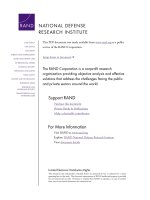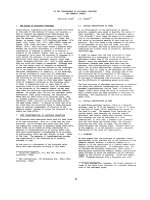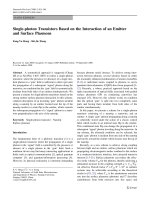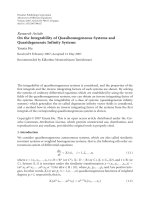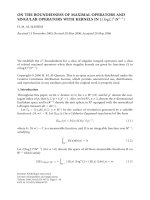Wishes on the occasion of birthday, wedding and new year’s holiday (or christmas) in british and vietnamese culture a comparative study
Bạn đang xem bản rút gọn của tài liệu. Xem và tải ngay bản đầy đủ của tài liệu tại đây (245.68 KB, 8 trang )
Wishes on the occasion of birthday, wedding
and new year’s holiday (or christmas) in
british and vietnamese culture: a comparative
study.
Phạm Thị Anh Đào
Trường Đại học KHXH&NV
Luận văn ThS. Chuyên ngành: English Linguistics; Mã số: 60 22 15
Người hướng dẫn: Assoc. Prof. Dr. Nguyễn Văn Độ
Năm bảo vệ:2010
Abstract: This thesis discusses some similaritties and differences in English and Vietnamese
ways of extending a wish. The focus of the analysis is on the content of expressions used in
wishing and non-verbal components of wishes, social factors having influence on extending a
wish and some cultural differences in extending wishes in Vietnam and Britain. The data for
this analysis are provided by the survey questionnaires that elicit wishes on three occasions
(birthday, wedding, and New Year/Christmas) to five different addressees, (a close friend, a
colleague, an acquaintance, a brother/sister, and a boss). 50 informants (25 English and 25
Vietnamese native speakers) have taken part in this elicitation. The content of expressions
used in wishing has been analyzed in relation to social-cultural and social factors, such as
age, occupation, gender, and living area. The findings of the study indicate that the
Vietnamese give the highest priority to family membership when they convey their wishes,
whereas the English prioritize social relationships. The analysis of the data has revealed
differences in the rating of occasions for wishing; thus Christmas is the most special occasion
to the English for extending one’s wishes whereas to the Vietnamese such occasion is
wedding. The English and the Vietnamese also differ in the ways they complement their
wishes; this varies depended on occasions and role relationships.
Keywords: Văn hóa Việt; Văn hóa Anh; Lời chúc; Giao tiếp.
Content:
iv
TABLE OF CONTENTS
PAGE
DECLARATION
i
ACKNOWLEDGEMENTS
ii
ABSTRACT
iii
PART A: INTRODUCTION
1
0.1. Rationale of the study
1
0.2. Aims of the study
1
0.3. Scope of the study
2
0.4. Methods of the study
2
0.5. Design of the study
2
PART B: DEVELOPMENT
3
CHAPTER 1: LITERATURE REVIEW
3
1.1. Speech acts and wishing
3
1.1.1. Speech acts and their classification
3
1.1.2. Wishing as a speech act
6
1.2. Politeness, face and wishing, a face-threatening act
7
1.2.1. Politeness
7
1.2.2. Face
8
1.2.3. Wishing as a face-threatening act
10
1.3. Relationship of language, culture and communication
10
1.3.1. Definition of language
10
1.3.2. Definition of culture
11
1.3.3. Definition of communication
11
1.3 4. Relationship of language, culture and communication
12
1.3.5. Wishing as a need of communication
13
CHAPTER 2: RESEARCH METHODOLOGY
14
2.1. Subject
14
2.2. Instrument of data analysis
14
v
2.3. Methods of data analysis
15
CHAPTER 3: DISCUSSION ON FINDINGS
16
3.1. SURVEY QUESTIONNAIRESAND INFORMANTS
16
3.1.1. Structure of survey questionnaire
16
3.1.2. Grouping of informants
17
3.1.2.1. Age
17
3.1.2.2. Gender
17
3.1.2.3. Living area
18
3.1.2.4. Occupation
18
3.2. VIETNAMESE FINDINGS FROM THE QUESTIONNAIRES
18
3.2.1. Comment on the content of Vietnamese wishes in three situations
18
3.2.1.1. Vietnamese birthday wishes
18
3.2.1.2. Vietnamese wedding wishes
21
3.2.1.3. Vietnamese New Year wishes
24
3.2.2. Comment on priorities in wishing
26
3.2.3. Comment on social factors governing the way of extending a wish
27
3.2.4. Comment on components of the act of Vietnamese wishing
27
3.3. ENGLISH FINDINGS FROM THE QUESTIONNAIRES.
28
3.3.1. Comment on the content of English wishes in three situations
28
3.3.1.1. English birthday wishes.
28
3.3.1.2. English wedding wishes
30
3.3.1.3. English Christmas and New Year wishes
32
3.3.2. Comment on priorities in wishing
33
3.3.3. Comment on social factors governing the way of extending a wish
34
3.3.4. Comment on components of the acts of English wishing
35
3.4. COMPARISON OF THE ENGLISH AND VIETNAMESE WAYS OF WISHING.
35
3.4.1. Major similarities
35
3.4.1.2 Occasions
35
3.4.1.2. Priorities in wishing
35
vi
3.4.1.3. Social factors governing the way of extending a wish
36
3.4.1.4. Accompaniments to wishes
36
3.4.2. Major differences.
36
3.4.2.1. Occasions
36
3.4.2.2. Priorities in wishing
37
3.4.2.3. Social factors governing the way of extending a wish
37
3.4.2.4. Accompaniment to wishes
37
CHAPTER 4: IMPLICATIONS FOR ELT
38
4.1. Learning a culture
38
4.2. Learning to avoid culture shock.
38
4.2.1. Some problems in culture shock.
38
4.2.2. Some potential culture shocks in wishing.
39
PART C: CONCLUSION
41
REFERENCES
42
ENGLISH SURVEY QUESTIONNAIRES
VIETNAMESE SURVEY QUESTIONNAIRES
1
PART A: INTRODUCTION
0. 1. Rationale of the study
English nowadays is considered the international language; it is the most widely spoken
language which is used in many fields such as economics, trade, tourism, diplomacy, politics,
and press. In Vietnam, as a result of the open door economic policy, the number of people
learning English for various purposes is on the rise. English is not only taught as an important
subject at thousands of foreign languages centers but it is also a compulsory subject in various
primary and high schools.
Although English has been taught in Vietnam for many years, not until recently has the
focus of improving linguistic competence for learners been on syntax, lexical and
phonological components of the language. Many people still believe that being good at
English means being good at linguistic components. Thus, cultural factors are paid little
attention to.
However, today, in our modern world in which globalization is expanding, the need of
integrating and communicating across nations is indispensable. Successful communication
requires not only purely linguistic competence but also the knowledge of social norms, social
values and relations between individuals known as communicative competence.
Communicative competence presupposes ability to use the language correctly and
appropriately. This pragmatic competence is as crucial as linguistic competence. The lack of it
may lead to impoliteness, misinterpretation, cultural shocks, and even communication
breakdown.
Hence, the knowledge about cross culture communication is really essential. On this
basis, this study is done to help Vietnamese learners of English to understand English ways of
expressing wishes. The focus of the study will be on similarities and differences between
Vietnamese and English forms of wishing.
0. 2. Aims of the study
The thesis focuses on studying the similarities and differences between English and
Vietnamese ways of wishing in respect to the following aspects:
2
- To investigate the content of expressions used in wishing and non-verbal components
of wishes.
- To find out social factors having influence on extending a wish and some cultural
differences in extending wishes in Vietnam and Britain.
- .To help Vietnamese learners of English have more awareness of English wishing and
of how to use it appropriately.
- To offer some suggestions to ELT (English Language Teaching)
0. 3. Scope of the study
The study mainly focuses on verbal communication and the analysis of the data collected from
the survey questionnaires on extending a wish. Similarities and differences between the
English and the Vietnamese in assessing the interference of social factors in wishing are
discussed. Also some common accompaniments and nonverbal cues together with wishing are
taken into account.
0. 4. Methods of the study
The main method of the study is the quantitative one with techniques:
- Consulting reference books
- Discussing with teachers and friends
- Conducting survey questionnaire
- .Studying relevant publications
- Resorting to personal observation.
0. 5. Design of the study: This study is divided into three main parts:
Part A: Introduction – including the reasons of the study, aims of the study, methods, scope
of the study and the design of the study.
Part B: Development, including 4 chapters
- Chapter 1: Literature review
- Chapter 2: Research methodology
- Chapter 3: Discussion on findings
- Chapter 4: Implications for ELT (English Language Teaching)
Part C: Conclusion
42
REFERENCES
In English.
1. Austin, J. L. (1962), How to do things with words, CUP, London-Oxford-New York.
2. Brown, H. D. (1986), Learning a second culture in culture bound edited by Joyce Merril
Valdes, CUP.
3. Brown, G and Yule, G. (1989), Discourse Analysis, CUP.
4. Do Thi Mai Thanh, (2000), Some English – Vietnamese Differences in Requesting, M.A
Thesis, CFU-VNU, Hanoi.
5. Goffman, E. (1967), Interaction Ritual: Essays on Face – to Face behaviours, New York:
Garden City.
6. Ha Cam Tam, 1998, Requests by Australian native speakers of English and Vietnamese
speakers of English. M. A, Thesis, La Trobe University, Australia.
7. Jackson, H and Stockwell, P. 1996, Investigating English Language-nature and function of
Language, Stanley Thrones Publishers.Ltd.
8. Lakoff, R. (1973), The Logic of Politeness: Minding your P’s and Q’s in Discourse, Guy
Cook, 1990, CUP.
9. Mey, J. L. (1993), Pragmatics: An introduction, Blackwell Publishers, London.
10. Nguyen Hoa, (2001), An introduction to Semantics, VNU, Publishing House.
11. Nguyen (Van) Quang, (1998), Vietnamese – American cross – cultural differences in
Extending and Encountering Compliment – as seen from communicative activities, PhD.
Thesis.
12. Nguyen (Van) Quang, (1994), Intercultural Communication, Hanoi National University,
College of Foreign Languages.
13. Nguyen Van Do, 1996, Politeness Phenomena in Vietnamese and English culture and
some implication in teaching languages, Hanoi Foreign Studies University.
14. Richards, J. C. (1985), Speech acts and Language Learning. In Richards(ed), 1985-The
Context of Language Teaching, CUP.
43
15. Richards, J. C, Platt, J. and Weber, H. (1990) – Longman Dictionary of Applied
Linguistics, Longman.
16. Richard, E. P & Larry, A. S. (1994), An introduction to Intercultural Communication,
Thomson Publishing House.
17. Searle, J. R. (1969), Speech Acts – An Essay in the Philosophy of Language, Cambridge,
Cambridge University Press.
18. Wierzbicka, A. (1985), Different cultures, different languages, different speech acts,
Journal of Pragmatics.
19. Wierzbicka, A. (1991), Cross – Cultural Pragmatics – The Semantics of Human
Interaction, New York: Mouton de Gruyter.
20. Yule, G. (1997), Pragmatics, Oxford University Press.
In Vietnamese.
1. Diệp Quang Ban (1972), Ngữ Pháp Tiếng Việt, Nxb Giáo Dục.
2. Phan Kế Bình (2001), Việt Nam phong tục, Nxb Văn hóa thông tin.
3. Hữu Đạt (2000), Văn hóa và ngôn ngữ giao tiếp của người Việt, Nxb Văn hóa thông tin
4. Cao Xuân Hạo (chủ biên) (19990, Ngữ Pháp Chức năng Tiếng Việt – Câu trong tiếng Việt,
Nxb Giáo Dục
5. Nguyễn Quang (2002), Giao tiếp và Giao tiếp giao Văn hóa. Nxb Đại học Quốc gia Hà Nội.
6. Trần Ngọc Thêm (1996), Tìm hiểu về bản sắc văn hóa Việt Nam, Nxb Hồ Chí Minh.
7. Trần Ngọc Thêm (1998), Cơ sở văn hóa Việt Nam. Nxb Giáo Dục


